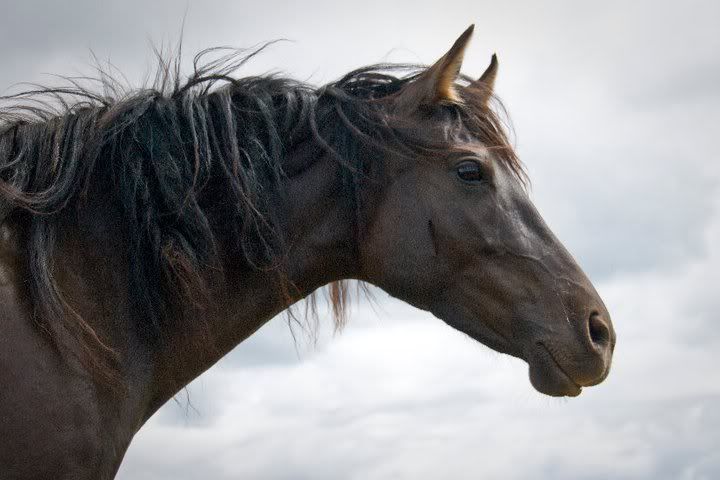|
|
Post by gotkiger on Oct 14, 2011 17:44:31 GMT -5
yes, I forgot to say that... very well said Duvers
|
|
|
|
Post by mystickiger on Oct 14, 2011 22:53:30 GMT -5
There has been plenty of discussion over the years about very dark grullo vs black. That conversation will continue to go the way as the very dark dun vs bay discussion. Everyone's opinion will vary. What is a proven fact to me is that very dark grullo ;black almost always reproduce themselves with dun or grullo offspring. I truthfully have not followed very dark dun;bay enough to offer an opinion on that.
Karen
|
|
|
|
Post by stormyranch on Oct 15, 2011 8:51:12 GMT -5
WEll Karen, Dino is bred to Lady Rose who will be the first Dun Kiger he has been bred to. He as not even bred a Kiger before. So it will be interesting I think. Also next year he will be bred to Lovely, Dark Grulla any guesses on color?  |
|
|
|
Post by DianneC on Oct 15, 2011 8:57:37 GMT -5
Since dark grulla and dark dun horses often produce dark grulla and dark dun babies it is hard to prove to some people. Its perhaps easier with dark gulla as a black horse is black all over, while dark grullas will be lighter under their tail, as Chinook is. Dark grullas are also born grulla with very obvious striping, some have even had ventral stripes, then change to their dark color when they shed their foal coat. I call Quil black, as she was born black and is black all over. However, her dorsal is longer and a deeper color (not faded) when she sheds out in spring, especially so her first spring.
So applying the same principles to bay dun is not a big leap of faith.
|
|
|
|
Post by kimk on Oct 15, 2011 17:12:46 GMT -5
my "dark grulla" mare lily shows her dorsal stripe loud and clear year round, although she appears black from a distance and was listed as black on her BLM paperwork. she also has obvious fawn coloring inside her ears.
Depending on whether or not Dino is homozygous for agouti will really be the determining factor in crossing him with a dark, or any other shade of grulla.
|
|
|
|
Post by DianneC on Oct 15, 2011 18:42:03 GMT -5
LadyRose will take care of the dun factor, just depends on if Dino has one sooty gene or two. Chinook has one, and Cruiser got it. Bravo has one and neither of his colts with LR got it, they were regular dun. Should be awesome for sure, whatever the color.
|
|
|
|
Post by kimk on Oct 16, 2011 3:45:32 GMT -5
is Lady Rose homozygous for dun?? I'm curious what makes you think Dino has a sooty gene, as opposed to agouti?
Did you have Chinook color coat tested? Inquiring minds want to know!!LoL
|
|
|
|
Post by gotkiger on Oct 16, 2011 9:23:55 GMT -5
if he is a zebra dun he has agouti as zebra dun is dun on a bay... soot is just extra and makes them darker
|
|
|
|
Post by stormyranch on Oct 16, 2011 10:12:53 GMT -5
Kim what is the difference between sooty and Agouti genes?
|
|
|
|
Post by kimk on Oct 16, 2011 15:03:51 GMT -5
|
|
|
|
Post by spanishsagegrullas on Oct 16, 2011 18:24:28 GMT -5
I also have to quickly jump in here because I read so much incorrect information all the time on countershading. Sooty and countershading are the same thing. Countershading is NOT a defined stripe on the back. It is shading that is counter to where the sun would shine on the back of an animal and reflect, making it easier for predators to see. The shading is counter to the sun, the darker color on the topline muddies the outline so that the animal is harder for predators to see. So the pictures are good examples of countershading.
My theory of countershading mixed with dun is that it is what causes the big wither patches, the neck patches, and the cobwebbing, as the dun factor stiples what would normally be a dark upper face mask (area from mid-nose up.) I have often noticed that areas of the mane directly above an area of neck shading do not have bicoloration, where as a lot of the rest of the mane does. I have several dun-factored horses that exhibit that trend.
Diane
|
|
|
|
Post by stormyranch on Oct 16, 2011 19:07:22 GMT -5
Thanks Kim,
I have never really researched this before, believe it or not. But color just isn't that important to me. It is interesting tho.
|
|
|
|
Post by Michelle Clarke on Oct 16, 2011 19:41:34 GMT -5
I came across this sight today and thought it was very relevant to our discussion. The stallion, Sagar, is a double dilute (perlino, which is bay with two cream genes); this means that all of his offspring will carry one cream dilution from him. Black is smokey black; chestnut is palomino; bay is buckskin. What I find interesting is that most of the foals also have the sooty gene. Some of the buckskins are way way dark. The website has small pictures but on the facebook page, they are easier to see. www.roanoakefarm.com/GoldenEdgeSporthorses-Home.htmwww.facebook.com/pages/RoanOake-Farm-Golden-Edge-Sporthorses-home-of-Sagar/184488358247173So, if the sooty really darkens those buckskins up so much, it can surely darken up the duns which do not lighten as much as the cream dilutions. |
|